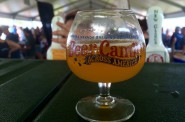The 13 Strangest Beers
Brews that add tea, oysters, bull testicles, you name it. Weird, yes, but some taste good.
Thanks to globalization, Americans are encountering beers once reserved for a certain population. In some cases, there was a reason these beers were hidden or fell into almost total disuse. But some out-of-the-mainstream beers can become cult favorites. Here are 13 of the strangest brews out there, which range from outlandish to astoundingly delicious to almost undrinkable.
Sahti: Best described as Finland’s answer to the Saison, Sahti is a strange and ancient brew that originated with Finnish farmers. A hop-less beer, Sahti is brewed using juniper berries and twigs, as well as an assortment of grains, both malted and un-malted. To further set this beer apart, the wort is filtered through juniper twigs giving the beer an earthy taste and texture. Alongside mead, Sahti was a favored drink among Viking settlers of Kieven Rus (a slavic kingdom in Eastern Europe), but until recent years, it could only be found in its homeland of Finland.
Notable Version: Norse Legend Sahti by Boston Beer Company
Braggot: Mead is an ancient and potent wine made from honey that is the subject of far too many Viking myths. So what do you get when you mix the drink of the gods with one of man’s favorite drinks? Braggot! Essentially mead brewed like an ale rather than a wine, or mead mixed with beer in some cases, Braggot’s history is hazy. Some say it dates back to the Viking age or earlier, while others say it emerged as the English crown’s preferred drink of choice in the 12th century. No matter where it came from, Braggot was well received across Europe in an earlier age, appearing in taverns and royal courts.
Notable Version: Beyond 2014 Braggot by Sprecher Brewing Co.
Notable Version: Hot Rocks Lager by Pizza Port Solana Beach
Gruit: Brewed across medieval Europe, Gruit is a classical un-hopped beer bittered using a collection of flowers, berries, and roots known as a gruit. By the 11th century, religious and political disorder in the Holy Roman Empire led brewers to adopt the practice of bittering their beers with hops rather than gruit to spite the Catholic Church, which held a monopoly on its ingredients. By the 16th century, hops were dominant ingredients in brewing and Gruit faded into obscurity. Half a millennia later interest in un-hopped beer has revived and with it Gruit has made a triumphant (in some quarters) return.
Notable Version: Gruit by New Belgium
Oyster Stout: Hailing from the British Isles, oyster stout originated as a traditional dry stout served with oysters as a meal, not in the drink. But at some point oysters were actually added to a stout; the benefits of using oysters in the brew, it turned out, include clarifying the beer, head retention, and mouth feel. The means by which the oysters are utilized varies from brewer to brewer: some boil them whole and remove before fermentation, while others grind the shells down and add them into the primary carboy. Either way, the oysters lend a briny, minerally, sea-like quality to the stout.
Notable Version: Pearl Necklace Oyster Stout by Flying Dog Brewery
Rocky Mountain Oyster Stout: A uniquely American invention that came as the result of an April Fool’s joke, Rocky Mountain Oyster Stout is similar to its Oyster Stout cousin. The only difference is that the Rocky Mountain version uses “bull testicles,” as rocky mountain oysters are sometimes dubbed. Yes, it’s strong stuff.
Notable Version: Rocky Mountain Oyster Stout by Wynkoop Brewing Company
Milk Stout: Yet another variation of traditional stout, milk stout gets it name from the addition of lactose, or milk sugar, during fermentation. Because milk sugar is non-fermentable, meaning it won’t be converted to alcohol by the yeast, the stout retains a distinct sweetness that separates it from the rest of the style’s variations.
Notable Version: Polish Moon by MKE Brewing Co.
Eisbock: Originating in Germany, Eisbock is a doppelbock beer that has been brewed traditionally but partially frozen prior to lagering. The ice that forms on top of the wort is then removed, concentrating the wort and increasing the body, flavor, and alcohol content. According to certain state laws, eisbock is technically a distilled spirit. Coupling this legal and marketing hurdle with the length and delicate nature of the freezing process has meant few American breweries touch this style.
Notable Version: Alaskan Eisbock by Alaskan Brewing Co.
Rauchbier: Originating as far back as the 16th century, this Bavarian specialty literally means smoked beer. Of course, the beer itself is not smoked. Instead, the brew is made by drying green malts over an open beechwood flame. The result is a brew that is smooth with a smoky character similar to that of smoked meat. The style nearly fell into disuse in the 18th century with advent of kiln dried malt, which doesn’t take on any smokiness. But the rauchbier style was revived by the craft brewing craze of the late 20th century.
Notable Version: Bacon Bomb by Brenner Brewing Company
Notable Version: Beard by Rogue Ales
Barley wine: First marketed in England in 1870, Barley Wine is not a wine at all, but rather a type of English Strong Ale. The wine name is because of this brew’s unusually high alcohol percentage, which tends to run between 8 and 12 percent. Today, there are two distinct styles of Barley Wine, the traditional English style, which tend to be on the high on alcohol and easy on hops, and American barley wine, which is commonly high in hops content.
Notable Version: Beer Line by Lakefront Brewing Co.
Chile Beer: Yet another odd American invention, Chile Beer is a trendy new style that is sure to turn (if not jolt) the heads of drinkers. This beer starts as a standard pale ale, or in some cases, a dark ale, but adds a variety of peppers such as roasted green chiles, jalepenos, or even the infamous ghost chile, to the fermenter. The result: a brew that’s hotter than the holes of Hell. It’s certainly not for everyone and more likely consumed on a dare than for pure enjoyment.
Notable Version: Ghost Face Killah by Twisted Pine Brewing Company
Tea Beer: Another beer with a hazy history but undeniably trendy, Tea Beer is a beer of any type, generally a wheat or pale ale, that has been infused with loose tea. It’s nothing so wild as a beer with bull testicles thrown in the brew kettle, but it is indeed a strange concoction.
Notable Version: O-Gii by MKE Brewing Co.
Beer City
-
The Crowd Rules At MobCraft Brewery
 Jul 7th, 2016 by Joey Grihalva
Jul 7th, 2016 by Joey Grihalva
-
Sierra Nevada Beer Camp Was a Winner
 Jun 13th, 2016 by Joey Grihalva
Jun 13th, 2016 by Joey Grihalva
-
The Rise of O’so Brewing Co.
 Dec 1st, 2015 by Christophor Rick
Dec 1st, 2015 by Christophor Rick
























Mead and beer? Sounds awful, but it might taste interesting! (Great idea for an article!)